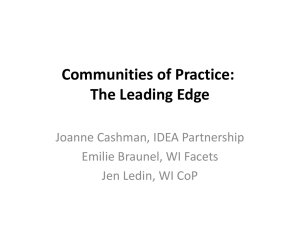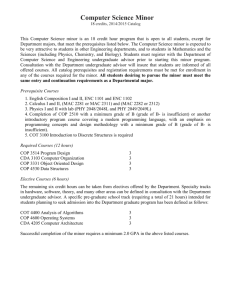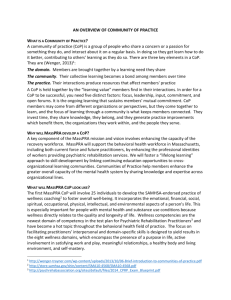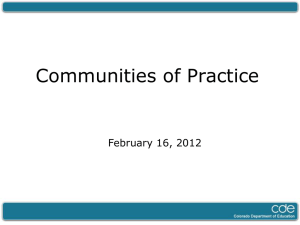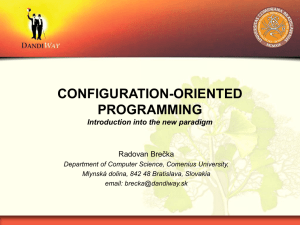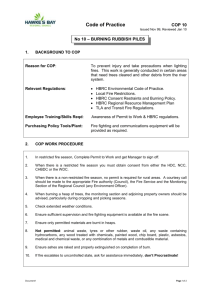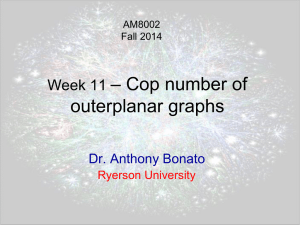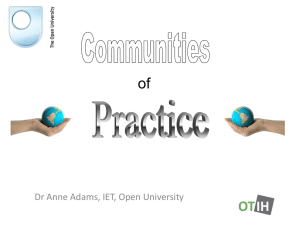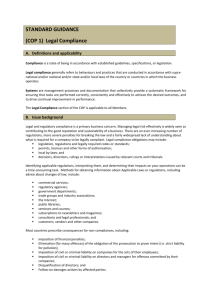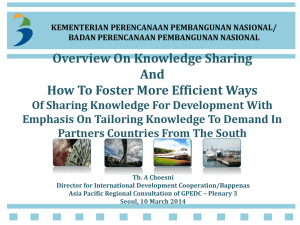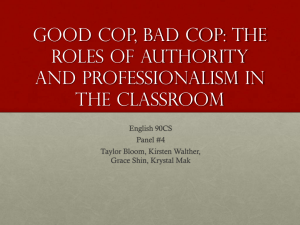- CATransitionAlliance
advertisement
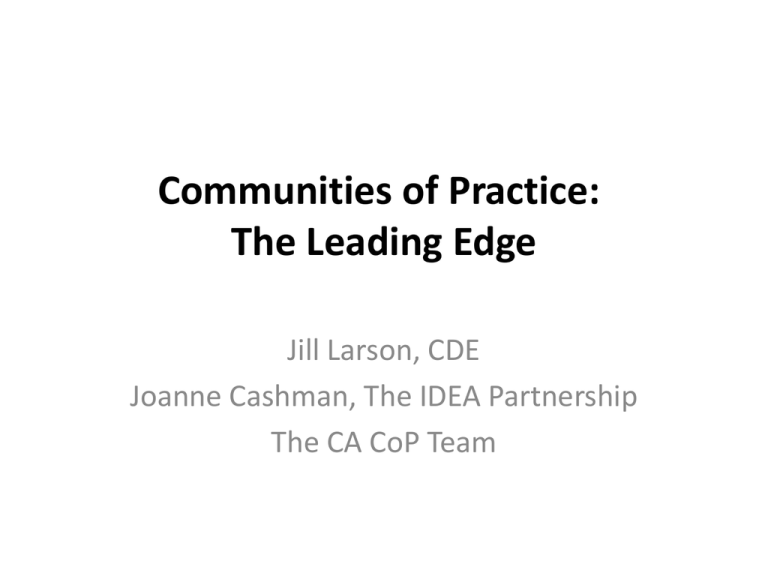
Communities of Practice: The Leading Edge Jill Larson, CDE Joanne Cashman, The IDEA Partnership The CA CoP Team Communities of Practice: The infrastructure to work across groups on issues of importance A way of working • Involving those who do shared work • Involving those that care about the issue • Always asking “who isn’t here?” A way of learning • Building on what each of the stakeholder groups know • Creating new knowledge grounded in doing the work together • Learning with those who can advocate for and make change What is a National Community? • Mechanism to build understanding across groups • Infrastructure for conducting an open dialogue around shared interests • Conduit for supporting shared work • Tool to look at issues at multiple levels of scale Multiple Levels of Scale : Learning Loops Built Through Community FEDERAL FEDERAL FEDERAL STATE STATE STATE LOCAL LOCAL LOCAL SITE SITE SITE INDIVIDUAL INDIVIDUAL INDIVIDUAL The National Community on Transition Who is Affiliated with Our Community? • 12 States • 12 National Organizations • 5 Technical Assistance Centers • Hundreds of Individuals How Are We Organized? • 10 state CoPs; national Practice Groups that cross states and networks • Create interaction through www.sharedwork.org • Monthly CoP Calls o Facilitate participation in existing efforts o Broker new opportunities • Use the networks of the community members to increase access to information • Use the community to bring the voice of the networks to the issues Building a CoP with Four Simple Questions • Who is interested in this issue and why? • What efforts are underway separately to address the work? • How can we build new connections? • What ‘real work’ goal could unite us? How Do Groups and Individuals Get Their Needs Met Within a Community? • Communities focus on ‘big picture’ goals (Transition) • ‘Practice Groups’ unite individuals with special interests or specific issues ( Youth Role, Accessible Transportation, etc.) • Practice groups help the community understand specific interests and issues in more depth • The community keeps the practice group focused on the ‘bigger picture’ • Both the ‘community’ and the ‘practice group’ are necessary to get needs met • Both the ‘community’ and the ‘practice group’ are necessary to respond to issues in context What Does a National Community Do? • Connect a group of community members that care deeply about unique issues • Affiliate individuals and groups that can be asked to help develop and/or support current initiatives Youth Role Employment Common Core Cradle to College and Career • Affiliate individuals and groups that can be invited into new initiatives • Maintains the communication necessary to enable the collaboration • Creates a sense of belonging that can bridge boundaries What is New about the Community We Are Creating Together? • Connecting with intentionality • Building the infrastructure to enable connections • Bringing decisionmakers, practitioners, consumers and youth into shared work • Reaching new levels of involvement for individuals and local programs • Modeling new ways to reach out and engage people • Building the network to sense emerging issues and evolving practice • Using the Community to raise awareness of new issues and new approaches • Always going for meaning…not just information • Living the commitment to seeking engagement from varied roles and diverse perspectives • Always asking .. .“Who is not here”? Raising the Profile of Stakeholders as Allies: The Human Side of Better Outcomes We want to set a community standard for engaging stakeholders that will inspire and lead us….an agreed upon set of behaviors that: – will shape how we approach transition work in our states organizations, schools and families – will define how we will begin to measure or success. – will be a common vision of how we model our beliefs in our own work. We call this standard … The Partnership Way A New Framework for Stakeholder Engagement Leading by Convening Ensuring Relevant Participation So Far… • What excites you most about the community? • What puzzles you most? • For you, where is the ‘value added’? Where Is the Value Added by Engaging the Stakeholders? Emerging First Thoughts • • • Build relationships that undergird real change • Sense issues before critical points • Specify the dimensions of an issue with those impacted • Identify shared interests • Move beyond organizational positions to shared interests • Unite the state and the stakeholders around common goals • Introduce two–way learning Develop connections to extensive and deep networks Create customized messages • Share aligned messages • When connected to state or federal efforts, extends capacity by building on the reach of existing networks Two-Way Learning Communicating to Learn What Works STATE TO LOCAL LOCAL TO STATE Communities in States: What’s the Potential? • Can we cross organizational boundaries to address persistent problems? • Can we find shared goals and define shared work? What Does the CA CoP Look Like? • Has formed and re-formed over the years…a continuing commitment to collaboration! • Focus on identification of needs across stakeholders • Moving from separate work to shared work • Co-convened this meeting! • Will share leadership of the opportunities that will go forward from it! What is the Composition of the Leadership Team? • • • • • • • • • • • • • • • Ed Amundson – California Teachers Association Sue Sawyer – CA Transition Alliance Dee Torrington – CARS+ Vicki Shadd – SELPA Richard Rosenberg – TPP Liz Zastrow - WorkAbility Loni Allen – Parents Helping Parents Gina Grecian – Rowell Family Empowerment Center Cathy Thoni – Diagnostic Center, North John Johnson – SDSU Patty Schetter – U.C. Davis MIND Institute Eddie Rea – Self-advocate Dan Boomer, Jill Larson, David Stang – CDE Susan Mathers – DOR LaCandice McCray – California Committee on Employment of People with Disabilities (CCEPD) Responsibilities of the Leadership Team? • Receive technical assistance from national experts and researchers (NSTTAC Capacity Building Institute) • Create a Statewide Action Plan • Get input from the CoP at large regarding the Action Plan • Implement the Action Plan • Include practitioners in the state to meet the goals of the Action Plan • Evaluate the effectiveness of the Action Plan The CA CoP Action Plan 1. Enhance the CA CoP structure and sustain the CoP Transition Leadership Team to complete and organize the capacity building action plan; identify goals and priorities, leaders, key stakeholders, timelines, outputs, indicators and data sources, and a definition of regional Community of Practice structures. 2. Develop and implement a multi-faceted capacity building strategy to identify best practices that lead to successful student outcomes. 3. Analyze statewide data to document outcomes, and identify successful models of success on a local, regional and statewide level. 4. Increase youth and family involvement and shared leadership in the implementation of evidence-based transition practices (EBTPs). The CoP as a Statewide Improvement Strategy. • What persistent issues could a statewide CoP address? • What promising practices could a stateside CoP promote? • In a state as large as California, how can the CoP continue to build relationships across groups? • How can you participate? Join the CA CoP Today! Email Subscribe to cacop@cde.ca.gov to be added to the CoP Listserv
